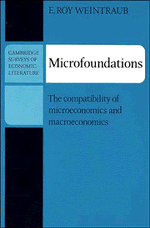6 - Walrasian equilibrium models
Published online by Cambridge University Press: 03 May 2011
Summary
It may be useful to recall the outlines of the Arrow–Debreu–McKenzie general equilibrium model, since this can be regarded as the starting point for subsequent work.
(1) There is a class of agents, called consumers, who have preferences over different bundles of final goods.
(2) The consumer preferences are sufficiently regular so that preferences can be represented by utility indicators.
(3) Consumers' income comes from sale of factor services and distributed profits of firms.
(4) Members of another class of agents, called firms, have preferences over output configurations, which lead to profits.
(5) Consumers, taking product and factor prices as given, attempt to maximize utility subject to their income constraint.
(6) Firms, taking product and factor prices as given, attempt to maximize profits subject to a technology constraint.
Under a variety of economic restrictions it can be shown that there exists a set of factor prices and product prices such that, if consumers and firms were to simultaneously optimize at those prices, the output and purchase of goods that would result entails those same prices. That is, there exists a set of prices (a competitive equilibrium) that could logically reconcile the potentially conflicting choices of all the economic agents. (The allocation of goods that corresponds to the competitive equilibrium is called the competitive allocation.)
This basic construction is far from concerns about speculative demands for money, real versus nominal interest rates, and flexible versus naive accelerators.
Information
- Type
- Chapter
- Information
- MicrofoundationsThe Compatibility of Microeconomics and Macroeconomics, pp. 89 - 108Publisher: Cambridge University PressPrint publication year: 1979
